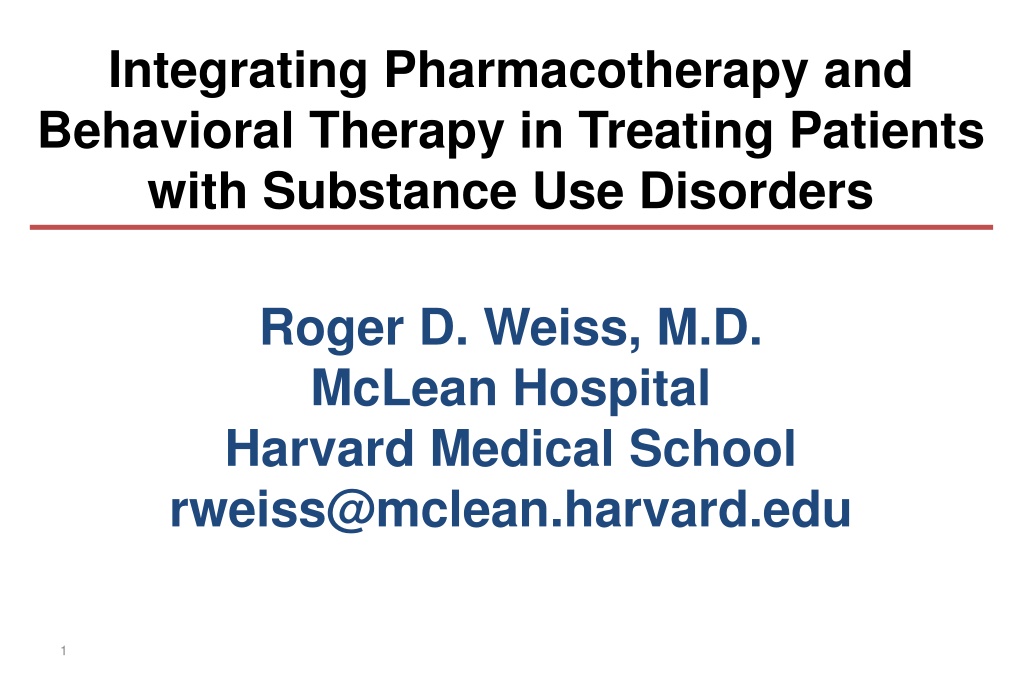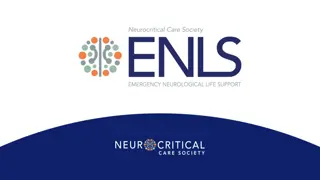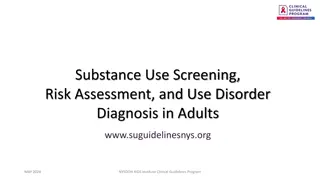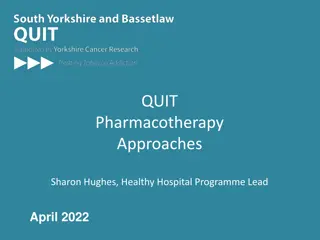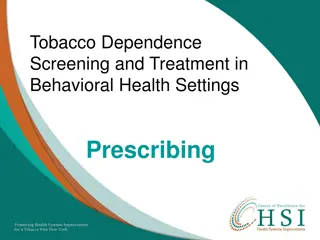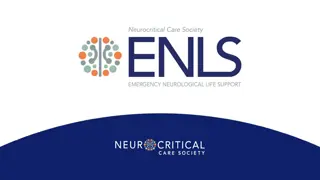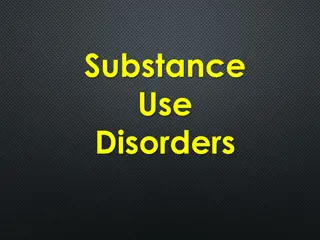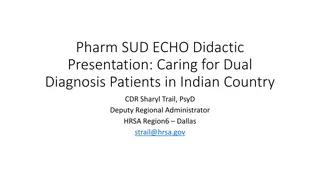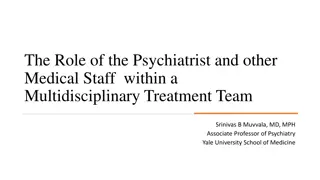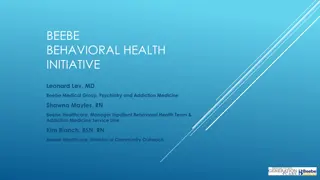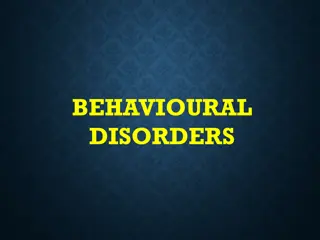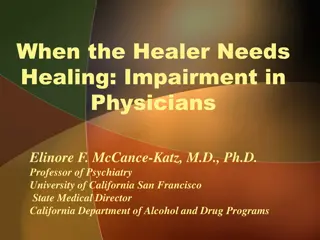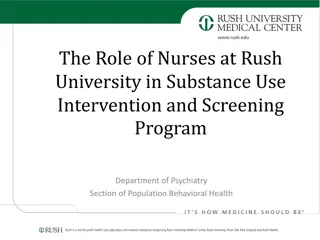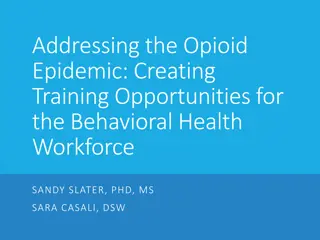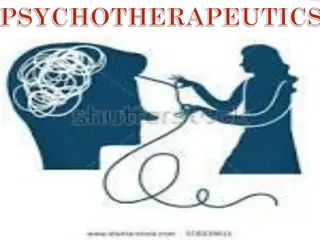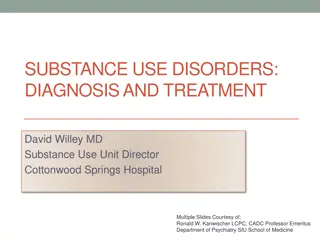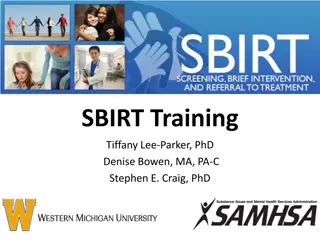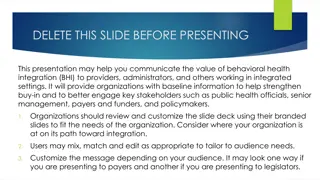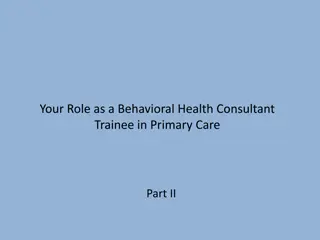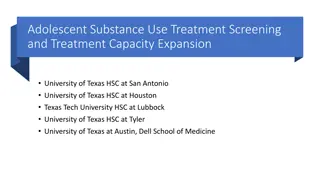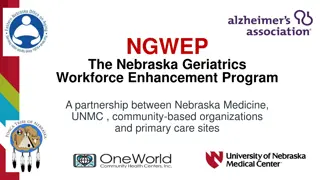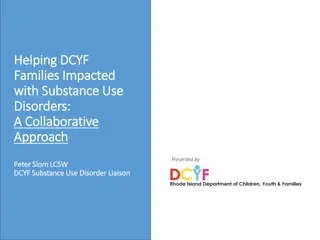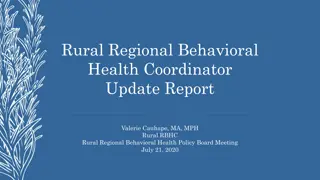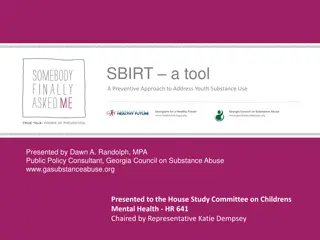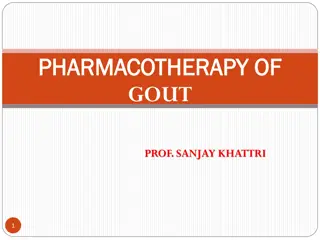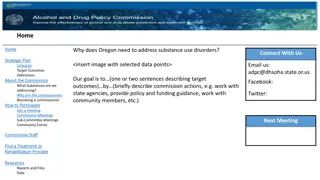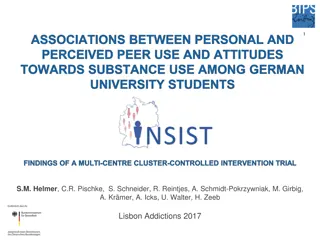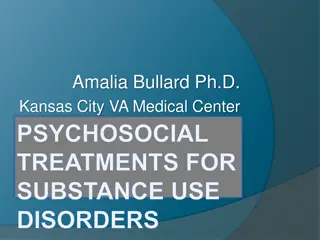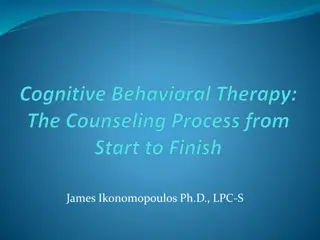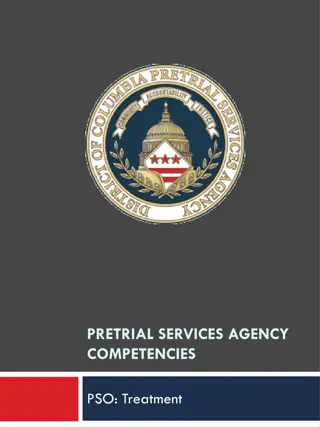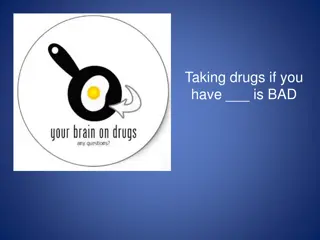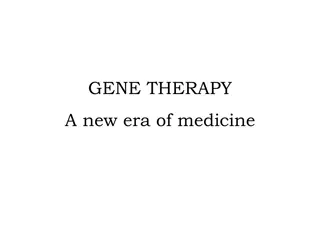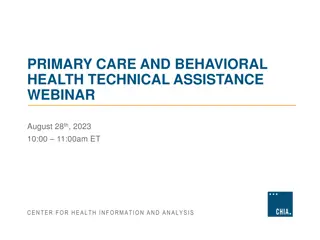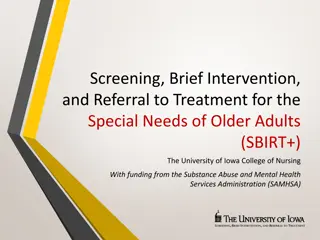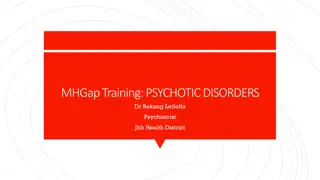Integrating Pharmacotherapy and Behavioral Therapy for Substance Use Disorders
This presentation by Dr. Roger D. Weiss discusses the integration of pharmacotherapy and behavioral therapy in treating patients with substance use disorders. It emphasizes the goals of behavioral therapy alongside medication treatment, focusing on medication adherence, defining and achieving substance use disorder goals, and addressing other issues like mental health and social factors that impact adherence. The importance of medication adherence, common reasons for patient non-adherence, and factors influencing adherence rates are also covered.
Download Presentation

Please find below an Image/Link to download the presentation.
The content on the website is provided AS IS for your information and personal use only. It may not be sold, licensed, or shared on other websites without obtaining consent from the author. Download presentation by click this link. If you encounter any issues during the download, it is possible that the publisher has removed the file from their server.
E N D
Presentation Transcript
Integrating Pharmacotherapy and Behavioral Therapy in Treating Patients with Substance Use Disorders Roger D. Weiss, M.D. McLean Hospital Harvard Medical School rweiss@mclean.harvard.edu 1
Disclosures Dr. Weiss has previously consulted to Alkermes, which manufactures extended- release naltrexone (Vivitrol)
What are the Goals of Behavioral Therapy in Addition to Medication Treatment? Medication adherence Define and attain SUD goals: abstinence or reduction Deal with other problems: mental and physical health, interpersonal, work/school, housing, etc. 3
Job 1: The Importance of Medication Adherence Medications only work if you take them. Many people don t take them.
Common Reasons for Patient Non-Adherence to Medications Medication-related Perceived or real ineffectiveness Intolerable side effects Cost Overly complex regimen
Adherence Rates by Dosing Frequency (Claxton, 2001) 1x/d 78% 2x/d 68% 3x/d 65% 4x/d 50%
Common Reasons for Patient Non-Adherence (2) Patient-related Denial of disorder Poor/no plan for treatment adherence Lack of understanding of the need for consistent dosing Misconceptions or fears about the medications Forgetfulness (perhaps in part due to the disorder or the medication)
Common Reasons for Patient Non-Adherence (3) SUD-related Desire to get high with the medication, e.g., taking too much Medication interferes with or blocks drug high Patient does not want to mix alcohol/drugs with medications Social support-related Family/friends/peer support group members discourage use of medication Perceived stigma attached to taking the medication
Common Reasons for Patient Non-Adherence (4) Medical professional-related Clinician unsure about treatment s effectiveness Poor communication about rationale, risks/benefits, and how to use the medication Psychiatric-related Severe depression/pessimism about treatment Anxiety about side effects Impatience waiting for medication to work (taking too much)
Strategies to Increase Medication Adherence The approach to the patient External reinforcement, e.g., family Prescribing patterns
Strategies to Increase Medication Adherence: the Approach to the Patient Actively discuss adherence issues Are you taking your meds? How much are you taking? Illness education (why patient needs medication) Ask about obstacles to adherence (e.g., comprehension, emotions, complexity, cost) Behavioral aids (Post-its, alarm on phone/watch)
Strategies to Increase Medication Adherence: External Reinforcements Family education Family support, e.g., disulfiram contract Contingency management, e.g., rewards for taking medication
Strategies to Increase Medication Adherence: Prescribing/Dosing Issues Simple regimens Pill boxes Longer-acting or forgiving medications Depot medications (e.g., injectable buprenorphine or naltrexone)
Pharmacotherapy of Alcohol Use Disorder
FDA-Approved Medications for Alcohol Use Disorder Disulfiram Naltrexone Acamprosate 15
Disulfiram Inhibits aldehyde dehydrogenase, an enzyme in the metabolism of alcohol Acetaldehyde poisoning when alcohol ingested Reaction occurs 10-15 min. after drinking Non-adherence very common Only suitable for patients seeking abstinence 16
Disulfiram Contract Incorporated as part of behavioral couples therapy Spousal monitoring Mutual thanking Thanks for taking your disulfiram. Thanks for reminding me and watching me. No discussion of past or future drinking outside of meetings with therapist 17
Disulfiram Contract Outcomes Reduced drinking Greater marital satisfaction Less intimate partner violence Better functioning in children 18
Naltrexone for Alcohol Use Disorder Mechanism of action: May reduce alcohol-induced craving (priming response) and alcohol reward Does not reduce likelihood of any drinking, but reduces likelihood of heavy drinking; helps contain a slip (lapse) rather than leading to relapse Comes in oral and extended-release (4-week) IM injectable form Like with disulfiram, non-adherence is very common, with resultant poor outcomes 19
Potential Value of Cognitive-Behavioral Therapy (CBT) with Naltrexone for Alcohol Use Disorder CBT includes discussion of abstinence violation effect Distinguishing between lapse (slip) and full-blown relapse Similar to mechanism of action of naltrexone 20
Naltrexone + CBT for Alcohol Use Disorder Anton et al. (2005) 160 pts on naltrexone or placebo randomized to 12 CBT or 4 motivational enhancement therapy (MET) sessions over 12 weeks Naltrexone (ntx) patients had longer time to relapse than placebo Ntx + CBT patients had best outcomes, better than ntx + MET Some conflicting studies on specific value of CBT with ntx 21
Acamprosate Mechanism of action: interacts with glutamate and GABA neurotransmitters systems May reduce protracted withdrawal symptoms 22
Acamprosate: Turning a Lemon into Lemonade Requires 3x a day dosing The tid method 23
NIAAA COMBINE Study Studied optimal combinations of medications, behavioral Tx for alcohol use disorder (N=1,383) Patients receive naltrexone, acamprosate, both, or neither; all pts receiving pills received Medical Mgmt Half of the patients received specialized psychotherapy (the Combined Behavioral Intervention, or CBI), in addition to Medical Management (MM) Results: Naltrexone, CBI both effective, but no combinations improved outcomes One cohort received CBI alone, no pills or MM: enabled an examination of placebo effect (CBI vs. CBI + placebo pills + MM) Anton et al., 2006
Percent Days Abstinent at Baseline (Past 90 Days) and Week 16 Percent Days Abstinent Baseline (mean) Week 16* (mean) Mixed model p-value 0.0002 CBI+MM+Placebo (n = 156) MM+Placebo (n = 153) CBI Alone (n = 157) 25 80 25 74 24 67 *Pair-wise comparison tests: 1 vs. 2, p = 0.04 2 vs. 3, p = 0.03 1 vs. 3, p < 0.001 Weiss et al., 2008
Active ingredients of MM Overall health check Advice to abstain from drinking Check on medication: efficacy, tolerability, adherence Advice to attend mutual-help groups, e.g., AA
Percentage of Patients Attending AA in the Week Before Baseline and During Treatment Patients Attending AA MM+Placebo Baseline During Treatment n % 24 32 n 3523 % CBI+MM+Placebo 34 22 51 33 CBI Alone 32 20 35 22 Chi-square = 7.38, df = 2, p < 0.03
Did AA Attendance Account for Better Drinking Outcomes in the 2 Groups Receiving MM + Placebo? AA attendance during treatment was a significant predictor of % days abstinent during treatment (p=.03) But When the overall analysis was adjusted for AA attendance during treatment, the differences remained significant (p<0.001) Partially
Pill-Taking A daily reminder of the reason for the pill-taking Reinforces recovery efforts An additional benefit of medication adherence
Pharmacotherapy of Opioid Use Disorder
OUD Medications: Agonist (Methadone), Partial Agonist (Buprenorphine), Antagonist (Naltrexone) 100 Full Agonist (Methadone) 90 80 70 60 Partial Agonist (Buprenorphine) Intrinsic Activity 50 40 30 20 Antagonist (Naltrexone) 10 0 -9 -8 -7 -6 -5 -4 Log Dose of Opioid 31
Buprenorphine and Behavioral Interventions
Drug Abuse Treatment Act of 2000 in U.S.A. Physicians must attest that they have the capacity to refer addiction treatment patients for appropriate counseling
What is Appropriate Counseling?
Prescription Opioid Addiction Treatment Study (POATS) Largest study of treatment of prescription opioid dependence (N=653 at 10 U.S. sites) Studied different lengths of buprenorphine- naloxone (bup-nx) + different intensities of counseling Success : abstinence or near-abstinence from opioids 7% success with 4-week taper 49% success while stable on bup-nx x 12 wks 9% success after 2nd taper after 12-wk bup-nx Adding counseling to bup-nx and weekly medical management did not improve outcome Weiss et al. 2011
Counseling in the context of buprenorphine treatment 4 major studies have shown that adding counseling to buprenorphine + medical management (MM) is not superior to buprenorphine + MM alone Carroll & Weiss, 2017
Key questions 1. Is buprenorphine that effective? 2. Is MM that effective? 3. Is counseling that ineffective for this population? 4. Are there subgroups of patients who benefit from additional counseling, including those with co-occurring psychiatric disorders?
Question #1: Is buprenorphine that effective? Wei
Is buprenorphine that effective? Compared to what? Yes-- but room for improvement
Question #2: Is medical management that effective? Wei
Active ingredients of MM Overall health check Urine monitoring Check on medication: efficacy, adherence, tolerability Monitor craving Advice to abstain Advice to attend mutual-help groups But, MM in these studies more intensive than community standard
Question #3: Are behavioral treatments that ineffective with this population? Wei
Are all behavioral interventions ineffective with this population? No
Are behavioral interventions that ineffective? 3 RCTs show benefit of behavioral tx All had either contingency management, computerized treatment, or both App-based interventions currently in use, some of them offering contingency management within the app Bickel et al., 2000 Schottenfeld et al., 2005 Christensen et al., 2014
RCTs vs. Real-world Results Non-randomized observational and database studies may yield different results from RCTs Different level of patient motivation No research infrastructure support
Are behavioral interventions that ineffective? Samples., 2022 Retrospective study of Medicaid data base, 2013-18 in ~5,000 pts with OUD 74% of pts had no or few (<1 day/month) psychosocial services 17% had low-intensity services (avg. <2 days/month) 9% had high-intensity services (avg. 7 days/month)
Are behavioral interventions that ineffective? Samples., 2022 Buprenorphine retention was higher in the 2 groups receiving psychosocial services Median days retained:136 vs.145 vs. 84 for high, low, and no services > 180 days retained: 42% vs. 43% vs. 32% for high, low, and no services Some patients do well with bupe and MM and no other psychosocial services
Are behavioral interventions that ineffective? Samples., 2022 Distinctions between data base studies vs. RCTs Non-randomized studies: high-intensity tx can reflect poor initial outcomes MM in RCTs could approximate low or even high-intensity services in database studies
Question #4: Are there subgroups that benefit from behavioral treatments? Wei
Are there subgroups of patients who benefit from behavioral interventions? POATS analysis compared outcomes of patients with and without additional counseling among those pts with More severe drug problems Co-occurring psychiatric illness
